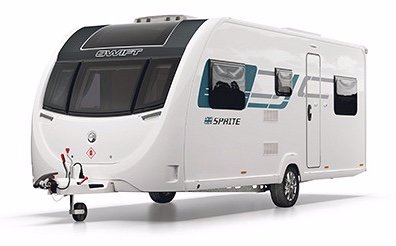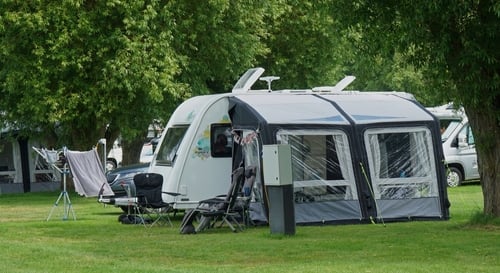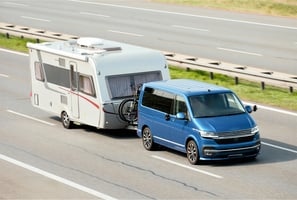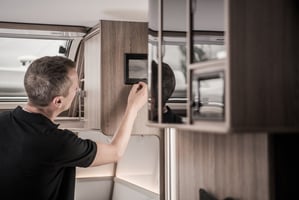What to think about when buying a secondhand caravan
It might look like a humble piece of kit, but to truly elevate your caravanning experience, one essential accessory stands out – and that’s the caravan awning. More than just a shelter, a caravan awning expands your living space, provides protection from the elements, and helps to create a sense of home wherever your travels take you. So let’s dive into the world of caravan awnings and uncover everything you need to know to make the most of your time on the road.
Essentially, awnings are versatile extensions that attach to the side of your caravan, instantly creating additional living space. Whether you’re seeking shade on a scorching day, shelter from the rain or simply looking for a cosy spot to unwind, awnings offer the perfect solution. From lounging in the shade to hosting alfresco dinners, these extensions seamlessly blend indoor comfort with outdoor freedom. They give you extra space and storage, and if you have an awning with side panels, a bit of extra privacy too. They are also something suitable to hang your fairy lights on, if that takes your fancy!
So what types of awning are there?
There are three main types of awning on the market today - the full awning, the porch awning and the combi awning, though you’ll find many different variations on these, such as inflatable air awnings, and specialist ones too. They can be operated in different ways, as there are several options such as wind-out, pull-out and automated controls. A bit like choosing a tent, you will need to decide on the type of fabric you want, the type of poles you require and also whether or not you will need a groundsheet.
Before making a purchase, take some time to assess your specific needs, considering factors such as the size needed, the weight you can manage to carry, and the compatibility with your caravan. Research reputable brands and read their reviews, and seek expert advice if you need it in order to make an informed decision that aligns with the specific function you need it to perform for you.
What size and specification?
Awnings are quite specific in size, so make sure you are buying the right one, especially if you are buying it secondhand. A typical depth for a full awning is 2.5 metres, but choosing one that is a bit bigger is ideal if you are thinking of using it as a designated ‘room.’ If you opt for over 2.5 metres, bear in mind you may need a larger pitch size when camping.
Ideally, the awning needs to be easy to put up and take down, without being too heavy, especially if you want to travel around lots in your caravan. If you want to leave it up on a seasonal pitch, however, and/or use it in the winter months, then something a bit more substantial is likely to be a better bet.
Full awnings are made to attach to the caravan on the full length of the awning rail. The manufacturer of the awning will have details on how you should measure your caravan, but for a full awning you should measure the distance from the ground level at one end of the caravan, up through the full awning rail and down to the ground level at the other end. Porch awnings can be various sizes depending on your preference, measured between two points on the caravan that cover the doors but avoid windows and vents, and are also fitted to the rail. Often a porch awning can be used for another caravan in the future, as they are versatile and may fit many caravan sizes. Combi awnings are a cross between a full and a porch awning and can provide a better weather seal than just a porch awning, however they are less versatile in where they can be placed on the caravan and they need a full rail available to attach to.
Awnings have classifications, which are useful to know. A winter awning is known as a Type W, and is able to take a specific load on top of it, for example snow. A residential awning - Type R - is for continual, extended use and can handle light snow. A lightweight awning is classed as a Type L, and is useful for general use and is lightweight in nature. Similar in nature to the Type L is a Type T - a touring awning - which is suitable for regular use but not when it is snowing.
An awning with removable sides also gives the opportunity of adding an annexe area, which can even be used as an extra bedroom. Roll out canopies are also an option, as they are easy to use and you can also add side and front panels to these, too.
Metal poles can be very heavy to carry around, especially if they belong to a full awning. Carbon fibre ones are less heavy, and therefore these are popular. Air awnings are light, due to not containing heavy poles and instead having inflatable tubes, and therefore these are very poplar these days too.
In terms of the fabric, synthetic polyester is often used as it is strong, durable and resistant to water, and can be coated/treated too. Polyester cloth can be found on some awnings, but it is not as hardwearing as the former. Acrylic-coated polyester provides water, fading and UV resistance, with some breathability. Generally, the heavier the fabric, the more expensive the awning will be - but as with many things in life, you get what you pay for.

Care and maintenance
They are obviously not cheap, so do look after your awning and it should then last you many years. They do often need reproofing to retain the effectiveness of any waterproofing, and it is generally recommended to do this once a year, with a reproofing liquid. Steel or aluminium poles can be wiped over with wax polish to prevent rust from forming. When it’s not in use, store your awning in an area away from damp, and in a dry place out of direct sunlight.
Be mindful of the weather
It’s not a good idea to have the awning left up in strong winds and heavy rain, as the fabric can be torn and the poles can bend. Keep it as secure as possible with a hold-down kit, and take it down in good time if the weather is due to take a turn for the worse.
Avoid damp and mould
Try not to take your awning down when it is wet, or it will stay damp. If you have no choice but to do that, then the next dry day remove the awning from the case and thoroughly air dry it then repack it. Remember to wipe the poles down, too.
Preventing sagging
The awning should be well tensioned and the roof should be sloped, to avoid water (or snow) collecting on it and creating any sag, which could stretch or ultimately damage the fabric or the poles.
Learn how to put it up (and take it down) before you go
It’s a well-known pastime for seasoned caravaners to be making a cup of tea, then settling down to watch some poor souls attempting to erect an awning for the first time! Although, perhaps it would be a good deed to actually wander over to assist before they start the divorce process…
Before you take your awning on the road with you, do have a few goes at practicing putting it up and taking it down. Remember that many need at least two people to put up safely.
If you are going to be carrying the awning inside your caravan, remember that it could take up quite a bit of space. One way to help with this could be to put it in your car, or in a roof box on the tow car, or you could portion it into several bags as opposed to one big bag.
Prevent caravan damage
A high percentage of caravans we purchase unfortunately have digs from awning pole damage - this is obviously something to avoid, and using storm straps can help with this. If it’s a roll-out awning make sure it is properly retracted and locked in before setting off, as this can cause a whole heap of damage to both the awning and the caravan during movement.

Use the extra space wisely
It is a really good idea to plan out your space and what you intend to put where before you set off. Awnings can provide great spaces for the pets to be, whether that’s for sleeping or just as a drying area; they can provide another bedroom, or they can be decent storage areas for equipment. The choices are endless…
Caravan awnings are an important part of travelling comfortably with your caravan. By understanding the types, materials, set-up process and customisation options, you’ll unlock the full potential of your caravan awning, which will help you increase the comfort and ease of each of your journeys. Enjoy!







